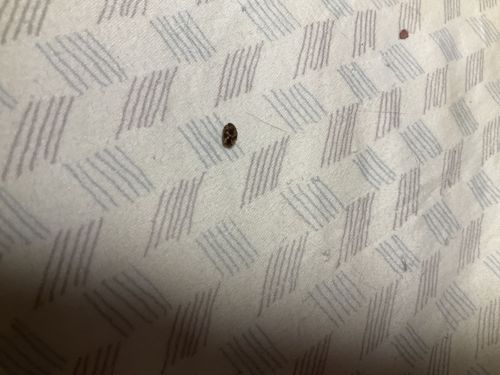Carpet Beetle (likely Varied Carpet Beetle or Black Carpet Beetle)
Scientific Name: Dermestes lardarius (Larder Beetle) or more likely a species from the genus Anthrenus (e.g., Anthrenus verbasci for Varied Carpet Beetle) or Attagenus (e.g., Attagenus unicolor for Black Carpet Beetle)
Order & Family: Order: Coleoptera, Family: Dermestidae
Size: Adults typically range from 2 mm to 5 mm in length. Larvae can be up to 5-6 mm.

Natural Habitat
Indoors, carpet beetles are found in quiet, undisturbed areas like closets, attics, storage rooms, under furniture, or in wall voids where their preferred food sources are present. Outdoors, adults are found on flowering plants.
Diet & Feeding
Larvae feed on a variety of animal-based products including wool, fur, feathers, silk, leather, museum specimens, taxidermy, dried meat, and pet food. They also consume synthetic fibers if mixed with natural ones. Adults primarily feed on pollen and nectar from flowers outdoors.
Behavior Patterns
Carpet beetles undergo complete metamorphosis with egg, larval, pupal, and adult stages. Larvae are the damaging stage, feeding on fibrous materials. Adults are often found near windows as they are attracted to light, or outdoors feeding on pollen. They can enter homes through cracks, vents, or open doors and windows. Larvae prefer undisturbed, dark areas.
Risks & Benefits
Risks: Can cause significant damage to stored natural fibers, clothing, carpets, upholstered furniture, and museum collections. Some people may experience skin irritation or allergic reactions due to contact with larval hairs. Benefits: In nature, dermestid beetles are important decomposers, breaking down animal carcasses.
Identified on: 8/20/2025